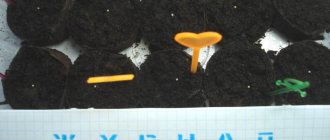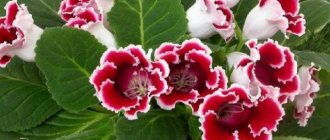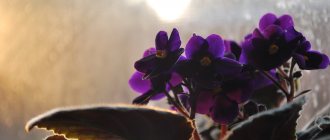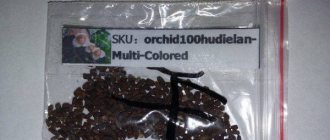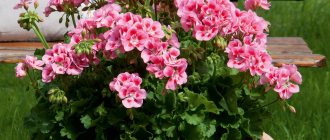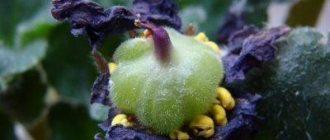You can buy an adult plant, but it long-term adaptation required, and it will cost more than seeds.
Is it difficult and how to grow adenium from seeds at home and on your own? Let’s look at the process step by step.
Choosing adenium variety
Nowadays there are a large number of subspecies and varieties of crops with beautiful flowering, so lovers of indoor plants are faced with a difficult choice of what exactly is worth growing. Popular varieties of adenium:
- Arab;
- Crispum;
- Mini;
- Swazicum;
- Soqotran;
- Somali;
- Fat.
Blooming adenium
Most often for indoor growing they take: Squasikum, Somali, Suchny or Mini. These plants are considered the most unpretentious of all the abundance of varieties, and they bloom earlier than others.
Before you figure out how to grow adenium, you should find out about the sowing time.
Somali adenium
Top dressing
Adenium seedlings develop and grow very quickly; in order to keep the flower in good shape, it should be fertilized. Nitrogen-containing fertilizers are best suited for this purpose. It is also necessary to remember that during the flowering period the plant should be fed with other fertilizers. For flowering adelium, potassium-phosphorus fertilizers are best suited as a top dressing.
Important! Any fertilizer for adenium must be diluted with water. The instructions say that there should be three times more water per substrate.
Some sources say that in winter it is best to stop feeding.
Selecting a container for sowing
Why Adenium does not bloom - reasons
A minimal size pot is the best container for seeds. In such a container, small plants will not suffer from excess humidity. The main requirement for the container is the presence of a large number of holes through which unnecessary moisture, harmful to the roots of the flower, will be removed.
The lid on the container is a significant advantage, because such a pot will serve as a small greenhouse. At the bottom of the planting container you need to lay out a drainage mixture (expanded clay, pieces of foam plastic, crushed brick or coal). Place soil on top and moisten it moderately.
Pots for adenium
Formation of caudex and roots
Beginner flower growers are interested in the question of how exactly the caudex is formed. Adenium is pushed out of the soil by the caudex, which in turn attaches to the root system. In the early stages of flower development, the decorative formation of the caudex begins. There are several ways to do this:
- When transplanting a seedling, its roots are raised slightly above the soil. In this case, the root system is slightly trimmed.
- The top of the adenium is pinched, and the tap root is cut off. It is necessary to process the cut areas. To do this, use paraffin, crushed activated carbon, and hydrogen peroxide. This procedure is carried out in order to avoid infection of the root system, and the flower begins to grow faster.
- The plant can be given various decorative shapes, for example, an octopus. In order to achieve this effect, it is necessary to place a flat stone on the soil prepared for replanting. After the root system is cut, the flower sits in the soil on this stone. The roots are placed around it in the shape of a fan and lowered into the soil. The top of the root system is sprinkled with soil. The stones need to be increased in size each time the flower is replanted. This procedure is carried out until the root system becomes stronger and begins to resemble the shape of an octopus.
Important! With each transplant, it is necessary to raise the flower above the soil by at least a centimeter. The main thing to remember is that it is not recommended to raise it high, as this can damage the flowering of the plant.
In order for the caudex to form correctly, it is very important to use a suitable watering system. The less the soil is watered, the faster the caudex grows and strengthens. The longer the soil is dried, the more beautiful it will be.
Soil preparation
Adenium - pruning and crown formation
The two main requirements for soil are nutrition and breathability. In terms of acidity, the soil should have either a weak or neutral indicator. Components of an ideal soil:
- coconut fiber – 50%;
- leaf-humus mixture – 25%;
- fine expanded clay (broken brick) up to 3 mm – 20%;
- foam crumbs - 1 handful;
- baking powder (vermiculite or perlite) – 5–10%.
Important! Peat has too dense a consistency, which will prevent root growth at all stages, so there is no need to use such soil.
Mixtures for succulents are also suitable for growing adenium at home. This product is diluted with crushed charcoal and coarse river sand that has been calcined.
Coconut fiber
Possible difficulties
This section contains a list of the difficulties that you may encounter when growing adenium:
- Excessive watering, brown spots appear on the leaves, they fall off, and the caudex may rot. Reduce watering. In case of rot, only cuttings.
- Underfilling . The caudex shrinks. We must not forget about watering.
- Pest damage: spider mites, mealybugs, etc. Treatment with acaricides and insecticides (Fitoverm, Sunmite, Aktara, etc.) will help.
- Poor growth or elongation. Unsuitable conditions of detention. Lack of light and heat, poor soil.
- Doesn't bloom. Most likely, it's not time yet. Correct the conditions of detention, do not forget to feed in the summer.
Growing desert rose at home is not at all difficult. Subject to proper maintenance conditions, this exotic plant will delight household members with its unusual appearance and bright colors.
How to plant adenium seeds correctly
When starting planting work, it is necessary to prepare the seed material. To do this, you will need a solution of potassium permanganate, where the seeds are placed for half an hour. Then a warm zircon solution is prepared and the material is left in it for another 2–3 hours.
Then the seeds are laid out on the ground and sprinkled with a small amount of the mixture. All that remains is to place the container in a room where the air temperature is +33... +35 °C.
On a note! Cooler temperatures mean that seedlings take a long time to germinate or do not grow at all.
Sowing in peat tablets
Planting adenium seeds in peat tablets follows the same principle as in a container with soil. You will need a lot of space to place individual cups with seedlings.
Adenium seeds
Basic landing rules
Adenium seeds are, in principle, not whimsical and can germinate under almost any conditions. But the future fate of the seedlings will depend on how you plant them. There are a large number of techniques that have their supporters and critics. We will try to provide the most complete information about the possible options.
Choosing a container for planting
You can choose absolutely any container for planting. But there is one condition - it should not be too large, since adeniums like close quarters. The larger the pot you take, the longer the root system will take to master it, which means the plant will not have enough strength to grow green mass. In addition, the smaller the container, the lower the risk of flooding.
50 ml disposable plastic cups or shallow food containers with a lid work well. But in any case, the results will be much better if you plant several seeds close to each other in one container. This way, the roots of the seedlings will meet resistance from the neighbor’s root system, which will speed up the process of developing the pot.
|
|
|
|
Selecting a substrate for planting
On this issue, the opinions of many adenium growers differ. But the topic of soil has always been and remains controversial. Some people prefer a sterile substrate to reduce the risk of mold and rot: perlite, lechuza-pon, ceramis and others. Some people like to germinate seeds on damp cotton pads, napkins or gauze. For some, it is important from birth to accustom the seedlings to the mixture in which they will grow in the future. For the purpose of prevention, it is advisable to sterilize such soil: steam it in a water bath, heat it in the oven or microwave.
|
|
In our store, we tried all possible methods, but did not notice much of a difference. The main thing is to use only the substrate that meets all the requirements for adeniums and is convenient for you. The main guideline is that it should be loose and light. You can read more in this article.
Soaking the seeds
There is still no consensus on whether soaking affects the germination of adeniums. We believe that there is nothing wrong with prevention, since fungal infections often affect crops in high humidity conditions. This can happen even when using a sterile substrate, because the fungus often hides on the seeds themselves.
Soaking is carried out for 15–30 minutes in warm water with the addition of the drug. Any of those presented below will be suitable for processing.
- Potassium permanganate solution (1%, light pink).
- Hydrogen peroxide 3% - 30 drops per glass.
- Fungicides: “Fitosporin-M” - 1.5 g of powder (0.5 teaspoon) per 100 ml of water; "Previkur Energy" - 1.5 ml per liter of water.
- Stimulants: "Epin" - one ampoule per liter; “Zircon” - 300 ml drop; “HB-101” 1–2 drops per liter of water; “Ribav extra” - two drops per 100 ml, “Heteroauxin” - six tablets per liter. These drugs will not kill the fungus, but the seedlings will be more resistant to infections.
If you buy very fresh seeds from Russian breeders, they most often do not need to be soaked. Such seed material has good germination and strong immunity. But species that germinate poorly and slowly are still worth processing.
|
Greenhouse
For successful germination of adenium, a greenhouse is a prerequisite. For this purpose, you can use either a ready-made container that can be closed with a lid, or a plastic bag or gripper placed on a glass or pot. But it is extremely important to ventilate it twice a day for 15–30 minutes, since without access to oxygen, seeds and seedlings are attacked by rot.
Bottom heating
The optimal soil temperature for seed germination is considered to be between 27 and 35°C. This is a very important condition, on which both the percentage of germination and the survival of seedlings in the future will depend. This is difficult to achieve without using bottom heating. That is why many adenium growers plant seeds in the autumn-winter period, when central heating is running in the house.
For bottom heating you can use: thermo-mats or special mats for reptiles, infrared heated floors, central heating radiators, a coil in the bathroom. The sun is also a good option, but, unfortunately, not the most reliable - because even on cloudy days, seedlings need warmth. In addition, young plants are very delicate, and the sun's rays, combined with condensation on the walls of the greenhouse, can cause burns.
| Thermal mats are very popular among gardeners, and now they are easy to get - many online stores sell them |
| In specialized stores you can purchase infrared film for heated floors. It is usually sold in lengths starting from one meter, and you will need the skills to connect it to the network. But there are also ready-made options. |
|
|
Backlight
If there is insufficient lighting, the seedlings will become very stretched, and ultimately this will significantly affect their appearance - you will not get a compact, fat one. But it is precisely the unusual forms of adenium that attract gardeners so much. Even in summer, we recommend germinating seeds under lamps and only gradually accustoming the seedlings to natural light. In autumn and winter, this is generally a mandatory condition, since the day length is too short for the full development of light-loving plants. You can read more about additional lighting in this article.
It is often difficult to combine additional lighting and bottom heating, especially when placing the greenhouse in the bathroom. Until the cotyledon leaves open, the seedlings can be kept in the dark, but then they should be transferred under a lamp. If you are using a common container, you should not wait for all the seeds to germinate; it is enough for the majority to germinate, the rest will catch up.
It is optimal to use bottom heating and lighting from the very beginning of sowing.
What affects germination
How quickly sprouts appear from the seeds depends on temperature indicators. Ideally, the room should be quite warm - 33-35 °C. Achieving such values is not very easy, so you will have to use lower heating to germinate the seeds. For this use:
- thermal mats;
- reptile mats;
- warm floor;
- heating batteries.
Adenium seedlings
Features of seeds
The seeds of Adenium, known as desert rose, do not look very viable. Their length is 1-1.5 cm, and visually they resemble rough sticks with hooks at the end and a light, gray-brown tone. Despite this, they germinate quickly.
Sprouts from such seeds - especially if they were pre-treated with liquid to stimulate growth - grow and strengthen on the surface in literally a week and a half.
At the same time, Adenium has good germination, comparable to the germination of the strongest succulents. And it can be improved if you choose the right substrate, planting container and cultivation algorithms.
Transplantation to a permanent place
When planting seed material in one common container, picking is carried out when the plants have 2-3 pairs of true leaves. The first pot should be about 50 ml. You can use disposable cups.
Note! If the root systems of seedlings are too intertwined, they must be separated as carefully as possible.
The next time adenium is planted at six months of age. For flowers that were planted in individual containers, this may be the first transplant. It is important to follow these rules:
- The culture is transplanted after it has completely mastered the existing capacity.
- It is not recommended to take a growing pot where there is a lot of free space. This way the plant will not be able to cope with the incoming liquid, which can cause the root system to rot.
Plants are transplanted to a permanent place from the age of one year, observing the following rules:
- It is not recommended to make very nutritious soil for adult flowers, since their nutrition is regulated by applying fertilizers. In a poor substrate, adenium will develop its caudex better.
- Plastic containers are excellent as pots for this crop. For those who are growing a flower for the first time, it is recommended to use transparent plastic to make it easier to determine the soil moisture level.
- Be sure to have a drainage layer at the bottom of the container.
- After transplanting, the plants can be watered only after 2 days. This time is enough for the injured roots to heal.
Transfer
Cuttings
Advantages:
- An established cutting can delight you with flowering in the coming year (how to make adenium bloom at home?).
- The plant will become a clone of the parent and will retain the color and shape of the flowers .
Flaws:
- Cuttings do not always .
- In specimens grown from cuttings, it is sometimes difficult to form a voluminous caudex with increased decorativeness (what are the conditions and methods for forming a caudex?).
The material for cutting adenium with cuttings is obtained after pruning the parent bush (how to prune adenium at home?). It is more rational to take material from the plant at the beginning of summer , after stable warm weather has set in - sufficient lighting and a warm atmosphere increase the percentage of plants that take root.
Adenium cuttings can be of any length, but the easiest to take root are 12-15 cm “sticks” with several leaves.
Not all solutions for speedy root formation can be used for adeniums. Therefore, it is better to let the cutting air dry for about 30 minutes , and then carefully stick it into the soil 5 centimeters deep , and then cover the container with a transparent polyethylene cover, a plastic half-liter glass, or a glass jar.
Important conditions for caring for rooted cuttings:
- The soil (2 parts perlite with 1 part vermiculite or 2 parts clean sand, 2 parts sphagnum, 1 part perlite) should be consistently slightly moist, but not wet;
- The plant must be provided with heat (25–35 °C) and light;
- When watering, you cannot .
Propagation by cuttings in water
Growing the root system of adenium cuttings is pure lottery.
With a probability of 50–70%, a cut branch may begin to rot.
But for some gardeners, cuttings still produce roots using this method of germination.
Rooting
How to root Adenium? For rooting, cuttings need from half a month to three . Branches that are separated from the bush and planted in the ground in warm weather acquire a root system faster .
If the procedure is carried out in early spring or late autumn, outside a special greenhouse, then you need to spread a mat with a heating function . Or place the container directly on the heating system line near the window .
Possible problems during cultivation
The plant has practically no pests, since its juice is poisonous. If the plant is given improper care, aphids, bugs and worms can grow in it. This happens if the soil is not moist enough. It is very easy to get rid of such pests; to do this, just treat the flower with a soap solution.
If the pot is too small or there is a lack of nutrients in the soil, the flower stops growing. This problem is also easy to deal with. With a lack of sunlight, the plant loses its color, especially the leaves.
